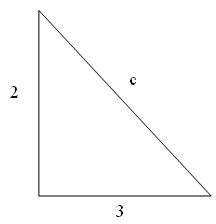wiemy że
[math] tg \alpha= \frac{2}{3} [/math]
więc automatycznie otrzymujemy
[math] ctg \alpha = \frac{3}{2} [/math]
I sposób wyliczania sin i cos
wiedząc że
[math] tg \alpha = \frac{\sin \alpha}{\cos \alpha} [/math] gdzie [math] \alpha \neq \frac{\pi}{2} + k \pi[/math]
i korzystając jeszcze z jedynki trygonometrycznej otrzymujemy układ równań
[math] \{ \frac{\sin \alpha}{\cos \alpha}=\frac{2}{3} \\ \sin^2 \alpha + \cos^2 \alpha = 1 [/math]
[math]\{ \sin \alpha = \frac{2}{3} \cdot \cos \alpha \\ sin^2 \alpha + cos^2 \alpha = 1[/math]
[math]\{ \sin \alpha = \frac{2}{3} \cdot \cos \alpha \\ (\frac{2}{3} \cdot \cos \alpha)^2 + cos^2 \alpha = 1 (*)[/math]
zajmiemy sie teraz równaniem (*)
[math](\frac{2}{3} \cdot \cos \alpha)^2 + cos^2 \alpha = 1[/math]
[math]\frac{4}{9}cos^2 \alpha + cos^2 \alpha = 1 [/math]
[math] \frac{13}{9} cos^2 \alpha = 1 \:\:\: / :\frac{13}{9} [/math]
[math] cos^2 \alpha = \frac{9}{13} [/math]
[math] cos \alpha = \sqrt{\frac{9}{13}}[/math] lub [math] cos \alpha = -\sqrt{\frac{9}{13}}[/math]
[math] cos \alpha = \frac{3}\sqrt{{13}}= \frac{3 \sqrt{13}}{13}[/math]
ostatecznie
[math] cos \alpha = \frac{3 \sqrt{13}}{13}[/math] lub [math] cos \alpha = -\frac{3 \sqrt{13}}{13}[/math]
powracamy do równania [math]\sin \alpha = \frac{2}{3} \cos \alpha [/math]
czyli
[math]\sin \alpha = \frac{2}{3} \cdot \frac{3 \sqrt{13}}{13}= \frac{2 \sqrt{13}}{13}[/math]
[math]\sin \alpha = -\frac{2}{3} \cdot \frac{3 \sqrt{13}}{13}= -\frac{2 \sqrt{13}}{13}[/math]
wiec
[math]\{ \sin \alpha = \frac{2 \sqrt{13}}{13} \\ \cos \alpha = \frac{3 \sqrt{13}}{13} [/math] lub [math]\{ \sin \alpha = -\frac{2 \sqrt{13}}{13} \\ \cos \alpha = -\frac{3 \sqrt{13}}{13} [/math]
II sposób
lub teraz przypomniał mi się
prostszy sposób. mamy trójkąt prostokątny (w załączniku) i wystarczy z twierdzenia Pitagorasa obliczyć przeciwprostokątną a.
[math] 2^2+3^2=a^2[/math]
[math]a^2=13[/math]
[math]a=\sqrt{13}[/math] lub [math]a=-\sqrt{13}[/math]
z funkcji trygonometrycznych dowolnego kata na podstawie tych danych otrzymujemy
[math] \sin \alpha = \frac{2}{\sqrt{13}}[/math] lub [math] \sin \alpha = -\frac{2}{\sqrt{13}}[/math]
[math] \sin \alpha = \frac{3}{\sqrt{13}}[/math] lub [math] \sin \alpha = -\frac{3}{\sqrt{13}}[/math]
po usunięciu niewymierności z manownika otrzymamy to samo co w pierwszym sposobie



